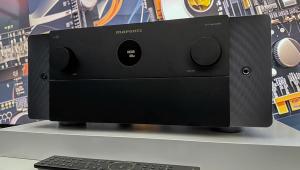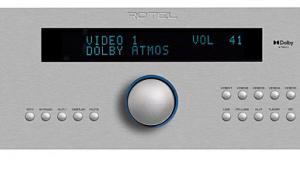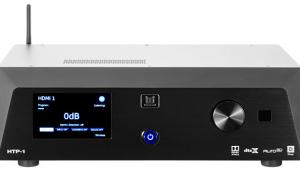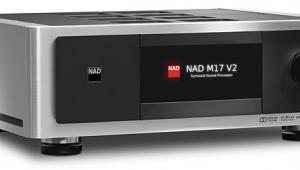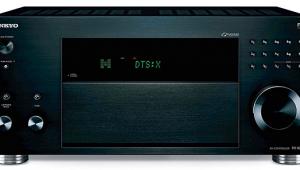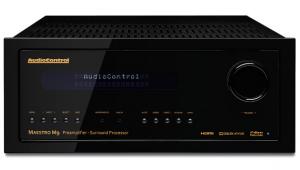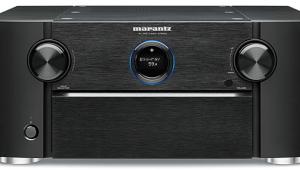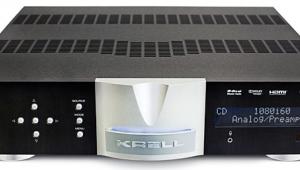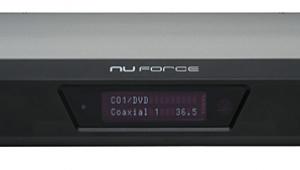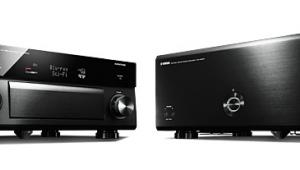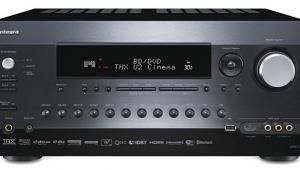Emotiva XMC-1 Surround Processor Review
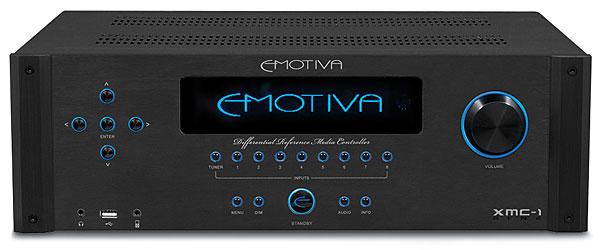
AT A GLANCE
Plus
Dirac Live speaker/room EQ
Highly flexible setup and automation options
Division I sound quality
Async-USB DAC input for streaming playback
Minus
Only one Dirac curve-set at a time can be loaded
Requires personal computer for setup; no onboard auto calibration
THE VERDICT
A noteworthy addition to the high-end preamp/processor ranks, with Dirac Live a fascinating, must-hear plus.
Talar du svenska? Emotiva does. Enough Swedish, at any rate, for the Tennessee tenderer of direct-to-consumer A/V gear to bake Swedish firm Dirac’s speaker/room-correction DSP into its new preamp/processor, the long-awaited XMC-1.
If you’ll forgive a Miller analogy, Dirac is to Uppsala University as Audyssey is to USC: Dirac, too, evolved out of original academic electroacoustics research—although USC’s weather is better, and I’m pretty sure the Trojans could take the Swedes on the gridiron.
Of Dirac’s several scalable DSP technologies for mobile, personal, and in-room audio playback, Dirac Live is the one inhabiting the XMC-1. Its conceptual architecture is quite similar to that of Audyssey’s MultEQ XT, with a couple of important distinctions. First, Dirac Live runs on an external computer to perform the initial number-crunching, ultimately downloading the resultant filter coefficients to the preamp’s onboard, dual-32-bit Texas Instruments DSP engine. (Emotiva thoughtfully provided me with a Lenovo laptop preloaded with the Windows software, which otherwise must be downloaded; a Mac OSX version is also downloadable.)
Second, and significantly, according to the Swedish tech team, Dirac Live employs “mixed-phase” digital filters, claimed to implement effective impulse (time-domain) corrections as well as frequency-response (amplitude-domain) ones. The mathematics of this are a bit above my pay grade—OK, they’re way, way above my pay grade—but the result is said to be improved resolution, imaging, and spatial presentation, along with the expected real-world, in-room frequency-response corrections. (You can experiment with Dirac Live on your Mac or PC in a free trial, available at dirac.com.)
Emotiva equips the XMC-1 with eight HDMI inputs, trios of coax and optical digital ports (plus a single AES/EBU input), and handfuls of analog paths, including a 7.1-channel analog-direct grouping, but there are no analog video facilities whatsoever—neither component nor composite nor S-video. And there’s no onboard video processing: The Emotiva is strictly a 3D/4K-ready HDMI switcher (HDMI v1.4b), a design approach I find perfectly sensible for the ’phile buyer today. In this market, either source or display (or both) is likely to incorporate adequate processing, should any be desired.
While we’re on the topic of HDMI: Emotiva specs the XMC-1’s v1.4b ports as fully capable with 30-frame-per-second 4K video and claims they in fact would handle 60/4K but for the lack of the critical HDCP 2.2 copyright management, for which the implementing chips that Emotiva plans to use are not yet available. The company says that a full HDMI v2.0 (with HDCP 2.2) upgrade will become available, at an unspecified future date (fairly soon, they hope), on a quick-turnaround basis (it’s a simple board swap). The upgrade’s cost is also still unspecified, but the Tennesseans stressed that it would be modest, and effectively “cost-plus”-priced.

Nine analog channel outputs include dual/stereo subwoofer outs, and all nine are present on both unbalanced RCA and balanced XLR jacks. I used the former; my power amp doesn’t supply balanced inputs, and anyway, I don’t feel that balanced connection offers any meaningful benefit to short runs.
Setup
Setting up the XMC-1 was a pleasure, at least after I received a second, properly functioning unit from Emotiva. The first they sent me, apparently invested by the unquiet shade of the late Harry Pearson, who despised all things digital, exhibited electronic behaviors reminiscent of that little girl in The Exorcist. Oddly, whatever inhabited this unit while in my possession left just as mysteriously, as company reps later reported they could find absolutely nothing wrong with it, even after a week of running it steadily.
In any event, the XMC-1’s setup system itself is workmanlike: The large, excellently readable OLED front-panel display is exactly mirrored onscreen, though in a default size small enough to make me crane a bit from my seating location 9 feet away. (You can stretch this, and change colors via the Setup menu, which helps a lot.) Once I got the hang of their grid-concept structure, menus proved perfectly straightforward and mostly self- explanatory. Inputs can be freely associated with connected sources, as well as extensively customized with regard to default stereo and surround listening modes, setup and equalization presets, and more.
The XMC-1 arrives from Emotiva with a license for Dirac Live LE. The full version I tested is a $99 upgrade, which differs from the LE version by one important attribute: The LE offers a valuable user-definable target-curve capability I’ll describe below. It also offers more flexible mic- and channel-gain adjustments, as well as the option to employ a third-party calibrated test mic. Given the XMC-1’s $2,499 price tag, I suspect the $99 Dirac upgrade box is one many buyers will choose to tick.
The XMC-1 has no built-in auto-calibration routine in the usual sense. Each channel’s distance, level, and crossover must be set manually via the menus—though the Dirac Live routine, when you run it, handles the first of these, but only for the Dirac preset (which is one of three). Consequently, I set these parameters the old-fashioned way, via a handheld SPL meter.
Emotiva provides a downmixing second-zone stereo-audio output, along with unusually flexible 12-volt trigger and IR options for system integration. A wired Ethernet connection links the preamp to a home network and thus the Internet—needed for Dirac’s software authentication, and for communication between the pre/pro and the local computer running Dirac Live. The Ethernet connection empowers full IP-based control in a third-party setup, but the XMC-1 itself has no onboard Web server.
The Dirac Live measurement and calibration routine requires that you connect the supplied higher-than-typical-quality measurement mic (USB) to the computer; it also requires that the computer and the XMC-1 cozy up on the same network. My standard home network worked immediately, the pre/pro auto-discovering it via DHCP on its wired connection, the laptop doing likewise via Wi-Fi.
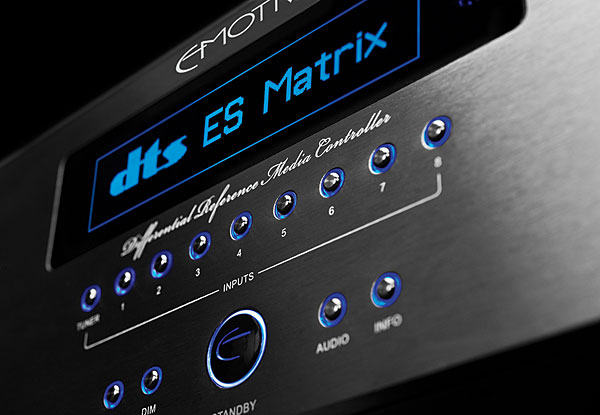
With communications established, I booted up Dirac Live on the laptop, which proved nicely self-prompting and not terribly different interface-wise from Audyssey’s system or several others I’ve tried. One functional distinction is that you must manually adjust the mic input, and individual channel-output gains fairly precisely, before you begin. (But you’ll have to do this only once, if you follow instructions well—don’t ask me how I know.) Dirac Live takes data from nine mic positions, prescribing quite specific locations depending on your seating layout, which it queries. (That said, my reading of Dirac materials online confirmed that it’s mostly the dimensional differences among placements, rather than adherence to specific locations per se, that foment the magic.)
The actual data-collecting routine consists of impulse stimuli, circulating to each channel, for each of the nine positions; once through, the whole routine took me about an hour. With all the data assembled, Dirac Live lets you view plots of the as-found response of each mic position (or averages) for each channel, with the corrected-response overlays, in either amplitude or impulse mode. It’s endlessly fascinating if you’re geeky enough to crave such info, and I am. Dirac’s is the best and most informative such display I’ve encountered among the half-dozen or so systems I’ve experienced, and the software is quick and responsive.
As with all speaker/room- correction systems I know of, Dirac Live’s filters strive to deliver real-world response fitted to an idealized “Target Curve.” Unlike many other systems, Dirac displays this onscreen, and lets you modify it at will. The XMC-1’s out-of-the-box Target Curve tilts downward about 0.5-decibel-per-octave from 100 hertz on up, which largely mirrors what I consider ideal for my system and indeed for most others. You can recalculate your data to a different target (or individual targets by channel) by manipulating curves onscreen, pulling down or up on curve “handles” you click into place, and you can store as many Dirac curve-sets (“Projects”) as you like on the computer. However, only one curve-set at a time can be loaded into the XMC-1, which makes comparisons between curves a 5-minute-per-switch affair at the least.
Overall, I found the Dirac Live app pleasantly straightforward and easy to use—once I noticed the tiny “Help” tab waaay over to the right, which revealed all when clicked. (Is the screen-edge, Where’s Waldo help tab a Windows 8 thing?)
Listening and Use
With its big blue display and intensely blue-backlit controls, the XMC-1 lights up like a Christmas tree when you turn it on. Fortunately,
all this is dimmable, right down to “off,” in the setup options. Since the Emotiva is really a Linux computer in A/V-preamp guise, the unit takes a full 40 seconds to come to life and pass audio and video from a cold start. (There’s an optional Video On Standby mode, which passes video and audio to the TV when the preamp is off and thus keeps the OS loaded, making full startup far quicker.)
Once on, the XMC-1 delivers the goods. I’m going to dispense with my non-Dirac listening fairly quickly here to conserve space: In stereo or unprocessed multichannel playback, the Emotiva sounded indistinguishable from my everyday pre/pro. Which is to say, essentially trans- parent, delivering programming as intended, whether in stereo or in surround. The XMC-1 includes both Reference Direct and “plain” Direct modes, which eliminate or limit processing (including Dirac), as well as Stereo and All Stereo (“party”) modes, which do not. Beyond these, what comes in is what comes out. The XMC-1 offers Dolby TrueHD and DTS-HD Master Audio, and it can employ PLIIx or Neo:6 post-processing to fill in channels missing in the original recording (and also, obviously, to perform matrix-decoding/synthesizing for surround from two-channel programs). Dolby Atmos and DTS:X object-based processing, the latest surround flavors of the month, are absent, perfectly understandable in what is, after-all, only a seven-channel pre/pro. Emotiva says it’s reserving Atmos and DTS:X for an upcoming more-channels model under development.
But as far as the listening goes, the real story here is the Dirac Live processing. As a rule, I report on familiar EQ systems like Audyssey’s only in brief, but Dirac’s, being a debut in these pages, presents a different case.
I spent considerable time comparing the XMC-1’s Dirac preset with its direct, non-Dirac Preset 1, which I carefully set with correct levels and distances. And I quickly heard a perfectly distinct difference.


